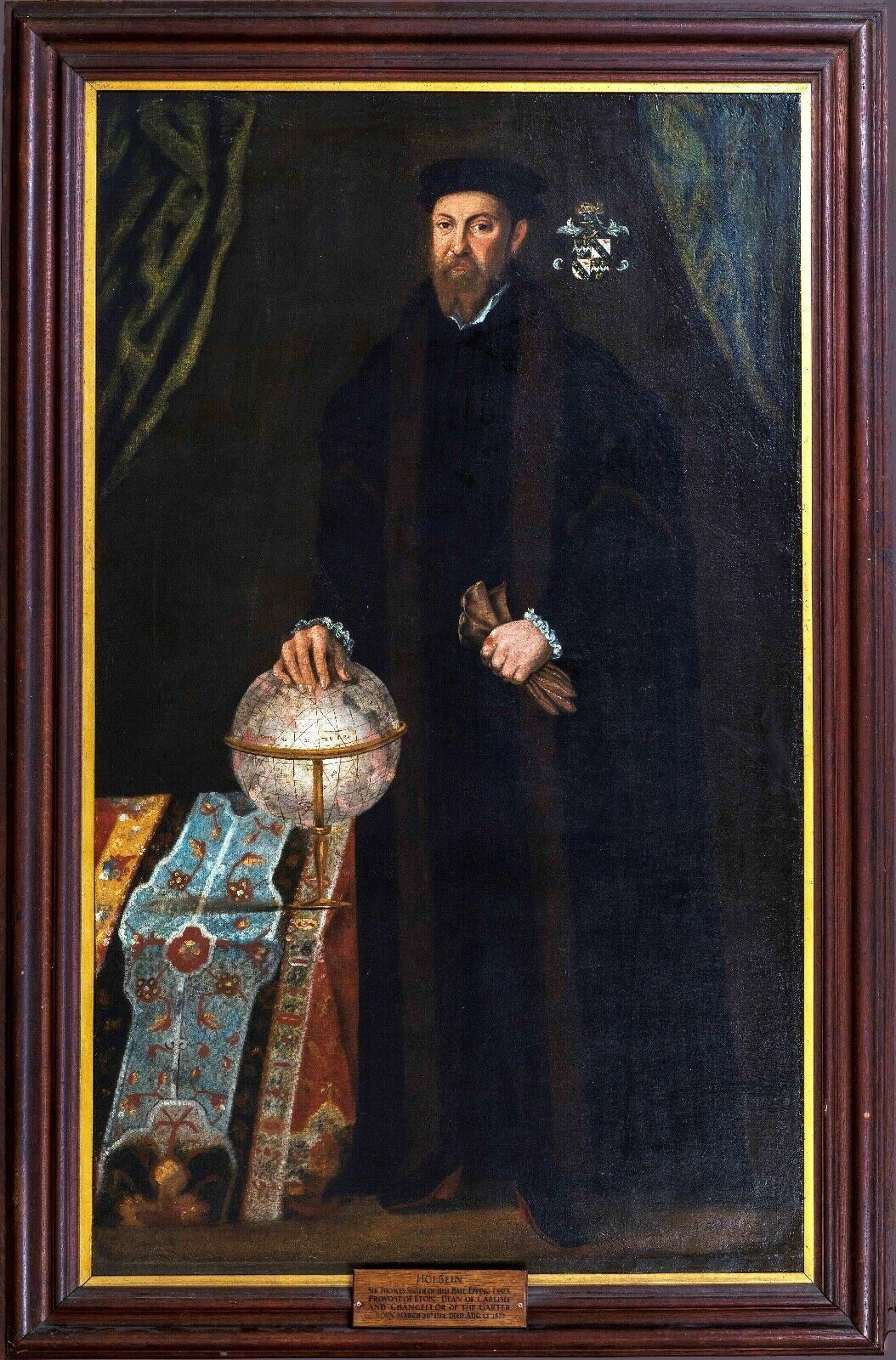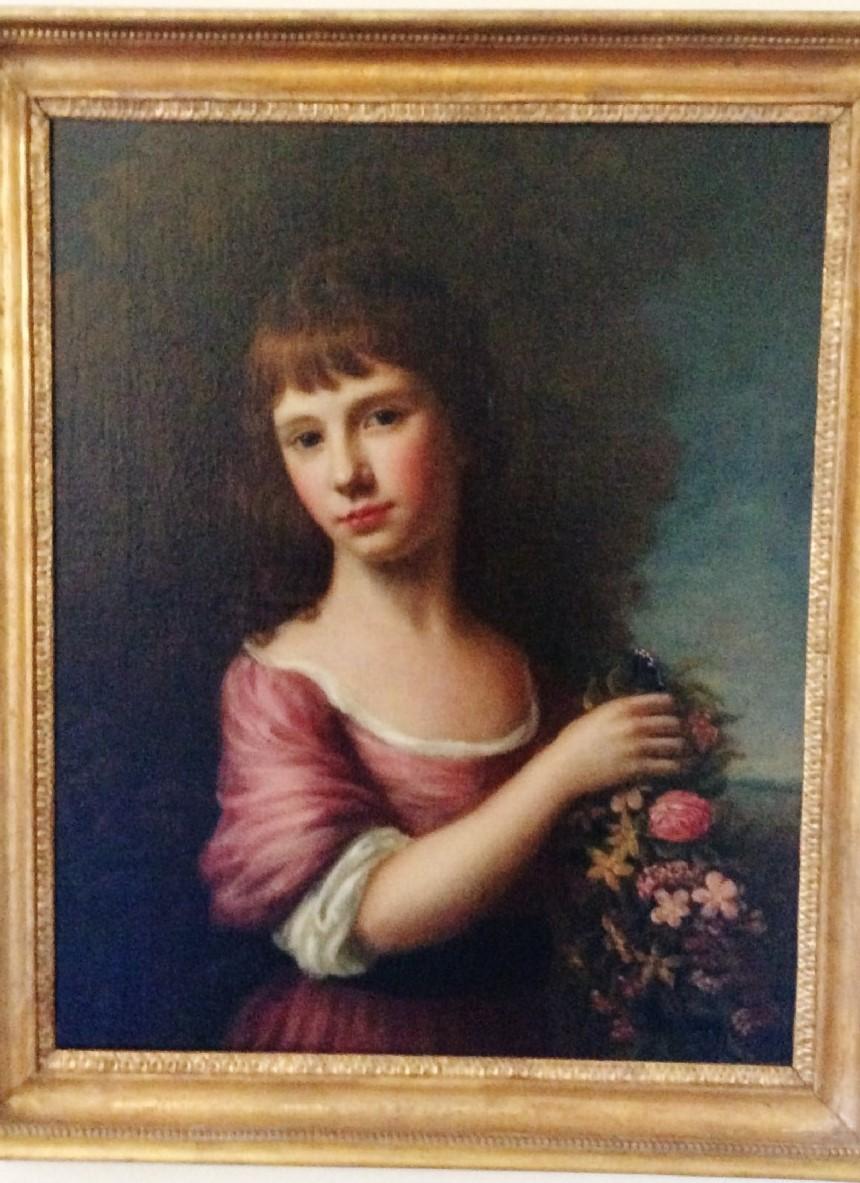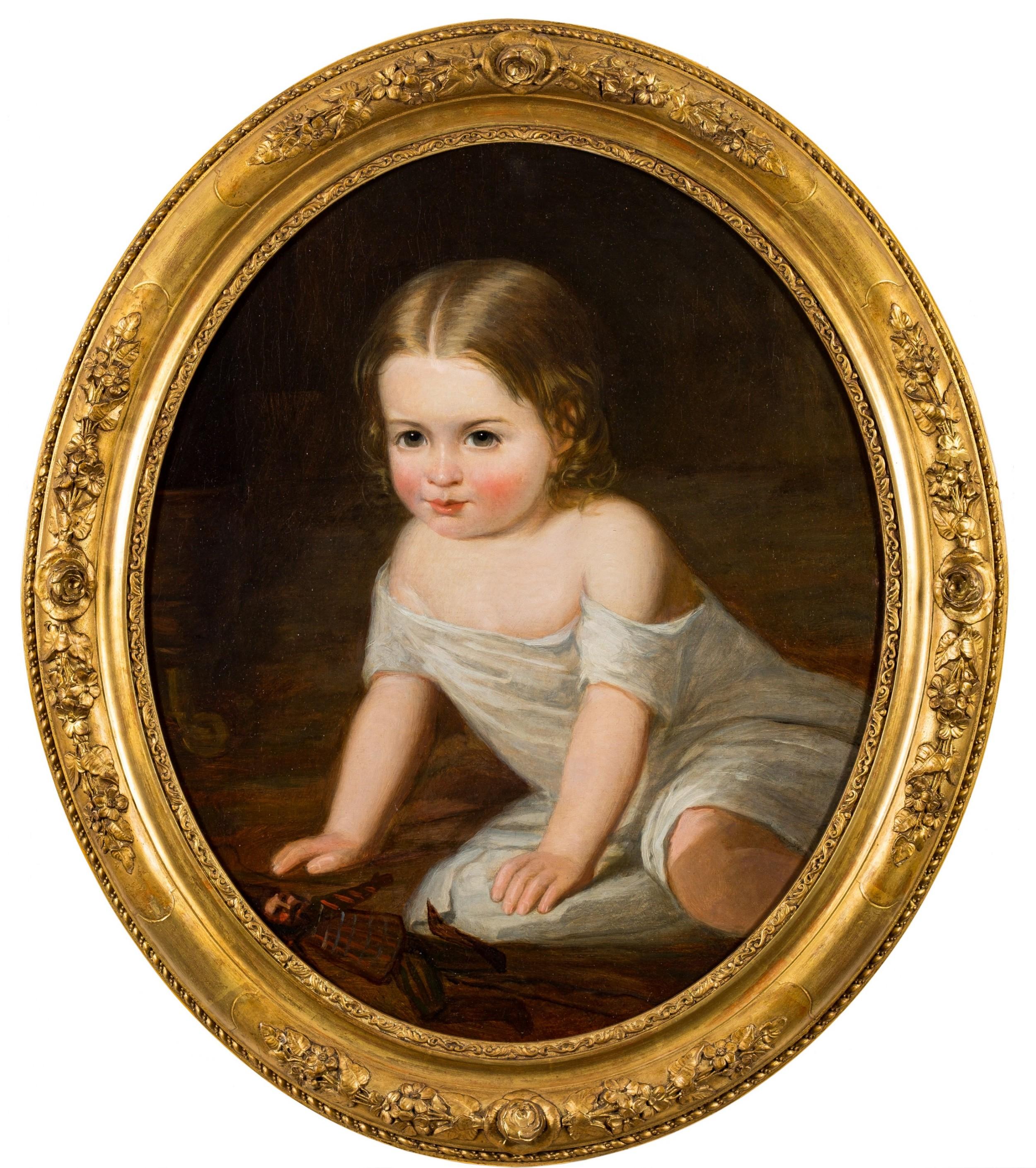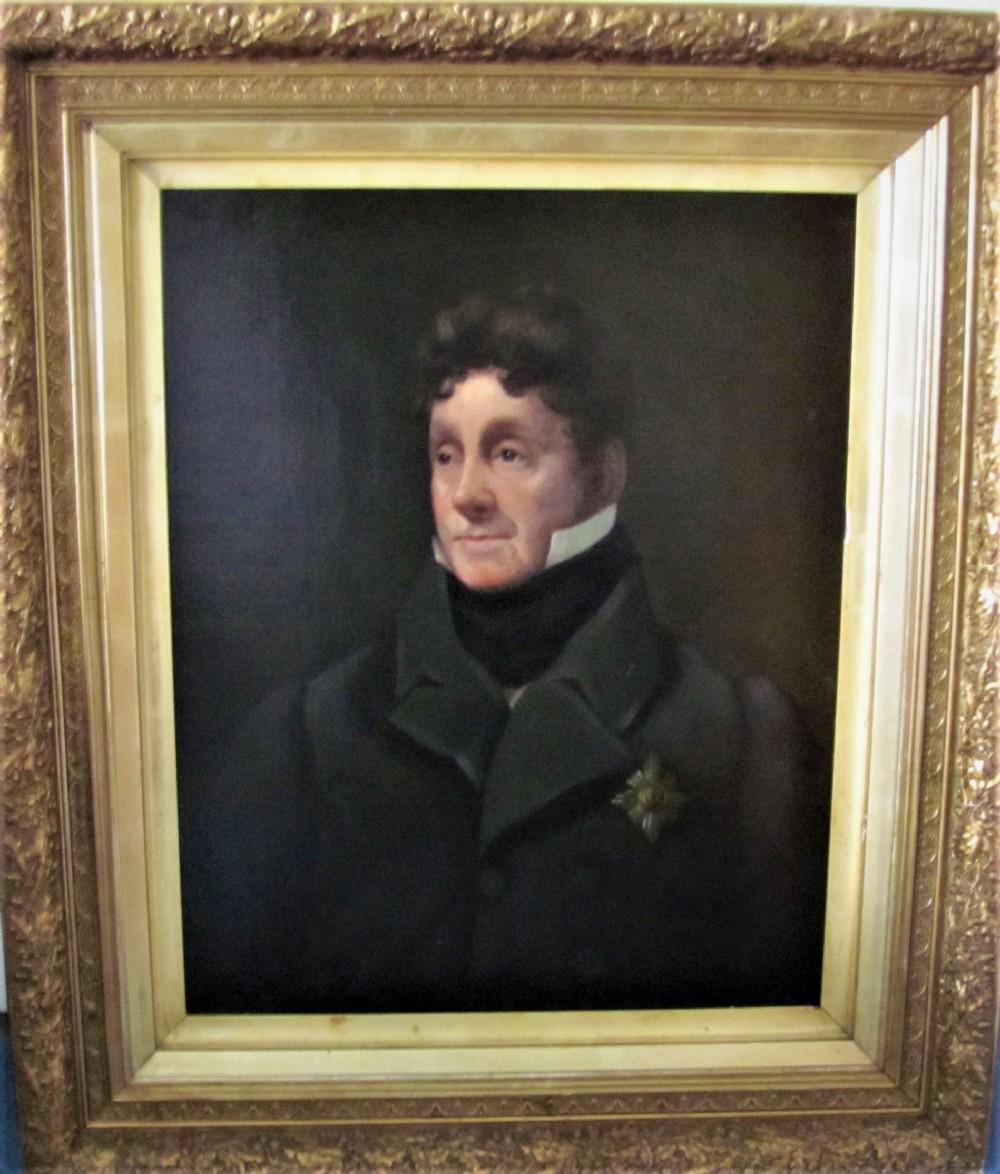Items Similar to Portrait of a Girl, 17th Century English School Old Masters Oil
Video Loading
Want more images or videos?
Request additional images or videos from the seller
1 of 9
Gilbert JacksonPortrait of a Girl, 17th Century English School Old Masters Oil 1620's
1620's
About the Item
Gilbert Jackson
English Active: 1620 - 1650
Portrait of a Girl
Oil on panel, signed upper left and Inscribed upper right
Image size: 24 ½ x 20 inches
Contemporary style hand made oak frame
This charming portrait displays many of the features attributed to Jackson. The sumptuous scarlet of her gown and teal background was also a recurring feature as his portraits often demonstrated a noticeably strong use of colour.
Other features of Jackson’s work are the detailed way in which he depicts costume and, in particular, his bold use of colour. Here the artist has chosen a teal background, which is strikingly bright next to sumptuous scarlet of the sitter’s gown and the ribbon in her hair. Jackson’s skill is evident in his handling of the light as it catches the lace on the dress and passes through the fine material of the intricate collar, and in the way that he brings across the light, wispy texture of the girl’s hair in contrast to the hard, smooth surface of the pearls at her ears and around her neck.
An inscription at the top of the painting gives us part of the artist’s signature, (upper left), as well as the initials and age of the sitter, (upper right). The sitter aged 14 is most likely the daughter of a noble family, painted during one of the artist’s trips outside London.
- Creator:Gilbert Jackson (1620 - 1650, British)
- Creation Year:1620's
- Dimensions:Height: 24.5 in (62.23 cm)Width: 20 in (50.8 cm)
- More Editions & Sizes:1 of 1Price: $93,375
- Medium:
- Movement & Style:
- Period:
- Condition:
- Gallery Location:London, GB
- Reference Number:1stDibs: LU5244901592
About the Seller
5.0
Gold Seller
These expertly vetted sellers are highly rated and consistently exceed customer expectations.
Established in 2007
1stDibs seller since 2014
66 sales on 1stDibs
Typical response time: 4 hours
- ShippingRetrieving quote...Ships From: London, United Kingdom
- Return PolicyA return for this item may be initiated within 3 days of delivery.
More From This SellerView All
- Portrait of a Man, 17th Century Dutch Oil on Panel PortraitBy Cornelis DusartLocated in London, GBCircle of Cornelis Dusart Dutch 1660 - 1704 Portrait of a Man Oil on panel Image size: 7¾ x 5¼ inches Giltwood frame Cornelis Dusart Cornelis ...Category
17th Century Old Masters Portrait Paintings
MaterialsOil, Panel
- Portrait of a Young Man - 17th Century Portrait in OilBy Pieter Harmensz VerelstLocated in London, GBCircle of Pieter Harmensz Verelst 1618 - 1678 Portrait of a Young Man Oil on oak panel Image size: 7 ½ x 5 ¾ inches Dutch ripple frameCategory
18th Century and Earlier Old Masters Portrait Paintings
MaterialsPanel, Oil
- Portrait of William Herbert, 3rd Earl of Pembroke, Early 17th Century PortraitLocated in London, GBEnglish School, (circa 1600) Portrait of William Herbert, 3rd Earl of Pembroke Oil on panel, oval Image size: 29¼ x 23⅞ inches Painted wooden frame Provenance: 176, Collection of Francis Greville, 1st Earl of Warwick. The Trustees of the Lord Brooks’ Settlement, (removed from Warwick Castle). Sotheby’s, London, 22nd March 1968, lot 81. Painted onto wooden panel, this portrait shows a dark haired gentleman in profile sporting an open white shirt. On top of this garments is a richly detailed black cloak, decorated with gold thread and lined with a sumptuous crimson lining. With the red silk inside it’s all very expensive and would fall under sumptuary laws – so this is a nobleman of high degree. It’s melancholic air conforms to the contemporary popularity of this very human condition, evident in fashionable poetry and music of the period. In comparison to our own modern prejudices, melancholy was associated with creativity in this period. This portrait appeared in the earliest described list of pictures of Warwick castle dating to 1762. Compiled by collector and antiquary Sir William Musgrave ‘taken from the information of Lord & Lady Warwick’ (Add. MSS, 5726 fol. 3) is described; ‘8. Earl of Essex – an original by Zuccharo – seen in profile with black hair. Holding a black robe across his breast with his right hand.’ As tempting as it is to imagine that this is a portrait of Robert Devereux, the 2nd Earl Essex, we might take this with a pinch of salt. Its identification with this romantic and fatal Elizabethan might well have been an attempt to add romance to Warwick Castle’s walls. It doesn’t correspond all that well with Essex’s portraits around 1600 after his return from Cadiz. Notably, this picture was presumably hung not too far away from the castle’s two portraits of Queen Elizabeth I. The first, and undoubtedly the best, being the exquisite coronation portrait that was sold by Lord Brooke in the late 1970s and now hangs in the National Portrait Gallery. The second, described as being ‘a copy from the original at Ld Hydes’, has yet to resurface. The portrait eventually ended up being hung in the State Bedroom of Warwick Castle. Archival documents present one other interesting candidate. The Greville family’s earliest inventory of paintings, made in 1630 at their home Brooke House in Holborn, London, describes five portraits of identified figures. All five belonged to the courtier, politician and poet Sir Fulke Greville (1554-1628), 1st Baron Brooke, and were hung in the ‘Gallerie’ of Brooke House behind yellow curtains. One of them was described as being of ‘Lord of Pembrooke’, which is likely to have been William Herbert (1580-1630), 3rd Earl of Pembroke. William was the eldest son of Greville’s best friend’s sister Mary Sidney, and was brought up in the particularly literary and poetically orientated household which his mother had supported. Notably, the 3rd Earl was one of the figures that Shakespeare’s first folio was dedicated to in 1623. The melancholic air to the portrait corresponds to William’s own pretensions as a learned and poetic figure. The richness of the robe in the painting, sporting golden thread and a spotted black fabric, is indicative of wealth beyond that of a simple poet or actor. The portrait’s dating to around the year 1600 might have coincided with William’s father death and his own rise to the Pembroke Earldom. This period of his life too was imbued with personal sadness, as an illicit affair with a Mary Fitton had resulted in a pregnancy and eventual banishment by Elizabeth I to Wilton after a short spell in Fleet Prison. His illegitimate son died shortly after being born. Despite being a close follower of the Earl of Essex, William had side-stepped supporting Devereux in the fatal uprising against the Queen and eventually regained favour at the court of the next monarch James I. His linen shirt is edged with a delicate border of lace and his black cloak is lined on the inside with sumptuous scarlet and richly decorated on the outside with gold braid and a pattern of embroidered black spots. Despite the richness of his clothes, William Herbert has been presented in a dishevelled state of semi-undress, his shirt unlaced far down his chest with the ties lying limply over his hand, indicating that he is in a state of distracted detachment. It has been suggested that the fashion for melancholy was rooted in an increase in self-consciousness and introspective reflection during the late 16th and early 17th centuries. In contemporary literature melancholy was said to be caused by a plenitude of the melancholy humor, one of the four vital humors, which were thought to regulate the functions of the body. An abundance of the melancholia humor was associated with a heightened creativity and intellectual ability and hence melancholy was linked to the notion of genius, as reflected in the work of the Oxford scholar Robert Burton, who in his work ‘The Anatomy of Melancholy’, described the Malcontent as ‘of all others [the]… most witty, [who] causeth many times divine ravishment, and a kind of enthusiamus… which stirreth them up to be excellent Philosophers, Poets and Prophets.’ (R. Burton, The Anatomy of Melancholy, London, 1621 in R. Strong, ‘Elizabethan Malady: Melancholy in Elizabethan and Jacobean Portraits’, Apollo, LXXIX, 1964). Melancholy was viewed as a highly fashionable affliction under Elizabeth I, and her successor James I, and a dejected demeanour was adopted by wealthy young men, often presenting themselves as scholars or despondent lovers, as reflected in the portraiture and literature from this period. Although the sitter in this portrait is, as yet, unidentified, it seems probable that he was a nobleman with literary or artistic ambitions, following in the same vain as such famous figures as the aristocratic poet and dramatist, Edward de Vere...Category
Early 17th Century Old Masters Portrait Paintings
MaterialsWood Panel, Oil
- Portrait of a Lady, 17th Century Flemish Oil Old MastersBy Jacob HuysmansLocated in London, GBJacob Huysmans Flemish 1633 - 1696 Portrait of a Lady Oil on canvas Image size: 49 x 40 ¼ inches Gilt frame Huysmans was born in Antwerp and came to England during the reign of Charles II where he became one of the fashionable painters of the court.. The diarist Samual Pepys noted the artist as capable of a more exact likeness than Lely. Certainly the diarist records that by August 1664 in the circle of Queen Catherine...Category
17th Century Old Masters Portrait Paintings
MaterialsCanvas, Oil, Acrylic
- Portrait of a LadyLocated in London, GBAttributted to Barthel Bruyn the Elder 1493–1555 Portrait of a Archduchess Margaret of Austria Oil on wood panel Image size: 10 inches (25.5 cm) Faux tortoiseshell frame Provenance North England Estate The Artist The date of Bartholomaeus (or Barthel) Bruyn's birth, 1493, can be deduced from a portrait medal by Friedrich Hagenauer which is dated 1539 and gives the artist's age as 46. The exact place of his birth is unknown, but was almost certainly in the region of the Lower Rhine. Bruyn entered the workshop of Jan Joest and assisted in painting the high altar of the Nikolaikirche, Kalkar, executed between 1505 and 1508. Also in Joest's atelier at this time was Joos van Cleve...Category
16th Century Old Masters Portrait Paintings
MaterialsOil
- Portrait of a Girl, 18th Century Oil Old MasterBy George KnaptonLocated in London, GBGeorge Knapton 1698-1778 Portrait of a Girl Oil on canvas Image size: 20 x 18 inches Original giltwood frame This beautiful half length portrait of a young woman, turned to left, gazing at the spectator, wearing a pink, white lace-embroidered, dress, in her hair a pink bonnet trimmed with lace to match her dress. The depiction of a young girl epitomises child portraiture of the late eighteenth century, in which painters such as William Beechey, Joshua Reynolds, Thomas Gainsborough had begun to discover and express the true character of children, in contrast to the stiff, miniature-adults of previous generations. The Artist Knapton was born in Lymington, one of four sons of James Knapton. He was apprenticed to Jonathan Richardson from 1715 to 1722, and in 1720 was a founding subscriber to the academy of St. Martin's Lane established by Louis Chéron...Category
18th Century Old Masters Portrait Paintings
MaterialsOil, Canvas
You May Also Like
- Portrait Of Thomas Smythe (1514-1577) School of Hans HOLBEIN (1497-1543)By Hans HolbeinLocated in Blackwater, GBPortrait Of Thomas Smythe (1514-1577), 16th Century School of Hans HOLBEIN (1497-1543) Fine huge 16th Century English Old Master portrait of Sir Thomas...Category
16th Century Old Masters Portrait Paintings
MaterialsOil
- William Wissing (follower) 19th Century Portrait Queen Mary IILocated in York, GBA 19th century oil on canvas, portrait of a young woman.This portrait is believed to be of Queen Mary II taken from an engraving of the painting, Halswell Park Sale, 1948, lot no.1323, Housed in a decorative gilt frame.Size overall being 70 x 86 cm high (27.5 x 33¾ inches approx) size of painting 54 x 68 cm (21 x 26 inches approx) To the rear of the portrait is a newspaper cutting of the engraving ,also a typed note regarding the provenance of the painting (see photo) Condition overall is very good, the Canvas has been relined, under UV there are areas of overpaint to bosom.Frame overall very good some minor self coloured losses Mary II (30 April 1662 – 28 December 1694) Mary, born at St James's Palace in London on 30 April 1662,eldest daughter of James, Duke of York (the future James II & VII) , and his first wife, Anne Hyde. Mary's uncle was King Charles II, her maternal grandfather, Edward Hyde, 1st Earl of Clarendon, served for a lengthy period as Charles's chief adviser. Mary married William of Orange. Willem Wissing, known in England as William Wissing...Category
19th Century Old Masters Portrait Paintings
MaterialsOil
- Nathaniel Hone, portrait of "flora" roman goddess, 18th centuryBy Nathaniel Hone the ElderLocated in York, GBI have great pleasure in offering for sale this beautiful portrait, by Nathaniel Hone, the elder. 18th century. The painting is of Ann Anderson, wife...Category
18th Century Old Masters Portrait Paintings
MaterialsOil
- 19th Century Portrait, Child At Play , Attributed To Henry Tanworth WellsLocated in York, GB19th century portrait, child at play ,Attributed to Henry Tanworth Wells A beautiful oval portrait of a young child at play, attributed to the portrait painter Henry Tanworth Wells. finely executed, this oil on canvas is in excellent condition. Housed in a period frame. The size overall is 79 cm x 62 cm whilst the painting is 56 cm x 46 cm Henry Tanworth Wells [1828-1903] Henry Tanworth Wells RA was an English miniature and portrait painter. He was a member of the Pre-Raphaelite circle though he painted in the academic style. His most popular painting...Category
19th Century Old Masters Portrait Paintings
MaterialsOil
- Henry Raeburn, (circle) 19th Century portrait of Sir Charles Forbes EdinglassieBy Henry Raeburn (circle)Located in York, GBPortrait of Sir Charles Forbes of Edinglassie, Oil on canvas. The size of the portrait is 75 cm x 59.5 cm whilst overall the size is 106 cm x 91 cm In very good condition.There has been some restoration/overpainting etc.There is some minor craquelure. Housed in a period gilt frame decorated with acorns and leaves Overall a good portrait, circle of a fine scottish artist , with an interesting sitter, his details below. sir Charles Forbes of Edinglassie Sir Charles Forbes, 1st Baronet (1774–1849) was a Scottish politician, of Newe and Edinglassie, Aberdeenshire. Forbes was the son of the Rev. George Forbes of Lochell. He was a descendant of Alexander Forbes of Kinaldie and Pitsligo, and was in 1833 served heir male in general to Alexander Forbes, 3rd lord Forbes of Pitsligo, father of Alexander Forbes, 4th Lord Forbes of Pitsligo, attainted in 1745. Forbes was of a bluff but kindly nature, diffident as to his own merits, of a straightforward and manly character. On the death of his uncle in 1821 Forbes succeeded to the entailed estates of the Forbeses of Newe, and was created a baronet by patent in 1823.[1] He married in 1811. His daughter, Elizabeth, married General, Lord James Hay, second son of the seventh Marquess of Tweeddale. Sir Henry Raeburn FRSE, RA, RSA (1756-1823) Scottish portrait painter and Scotland's first significant portrait painter since the Union to remain based in Scotland. He served as Portrait Painter to King George IV in Scotland Raeburn had all the essential qualities of a popular and successful portrait painter. He was able to produce a telling and forcible likeness; his work is distinguished by powerful characterisation, stark realism, dramatic and unusual lighting...Category
19th Century Old Masters Portrait Paintings
MaterialsOil
- English Portraits of Lady, Dorothy & Jane Wood c.1750, Remarkable Carved FramesBy John Theodore HeinsLocated in London, GBPortraits of a Lady, Dorothy and Jane Wood c.1750, Fine Carved Frames By John Theodore Heins (1697-1756) Titan Fine Art present these works, which formed part of a collection of family heirlooms of the Wood family who were from Bracon Ash, Norfolk, since the medieval period. Jane’s daughter Ann, was famously married on board the Foudroyant, off Naples, in a lavish ceremony in 1799, with Lord Nelson himself giving away the bride. The paintings descended within the family for around 275 years until recent and are exquisite examples of Georgian portraiture in England and are some of the best works by the artist. The original hand carved and gilded pierced frames are magnificent works of art in their own right. The sitters were two children, out of several, of Thomas Wood (1682-176) and Dorothy Huby (1700-1759). The family is from Norwich, which in 1720 was a city second in importance only to London. Their aunt, Jane Wood (1677-1756), was a Franciscan nun in Bruges. Dorothy Wood (in the blue dress) was baptised 2nd June 1726 and she died unmarried around 1759. Jane (in the pink dress) gave birth to at least six children during her thirty two-year marriage. She was baptised 14 Oct 1727 at Bracon Ash. Jane married Knipe Gobbet (1730/5-1791) who was Sheriff in 1768 (and Mayor in 1771) of the City of Norwich, and later Lieutenant-Colonel of the West Norfolk Regiment, in which corps he had served in for many years. According to Payne’s Universal Chronicle or Weekly Gazette the marriage took place on 7th July 1758. Knipe was born at his family seat, Tacolneston Hall, to parents George Gobbet, who was Sheriff in 1710, and Ann. The couple bought and lived in a house in Norwich (later known as Gurney’s Bank House) until 1778 before moving to another one at 10 St Stephen’s Street, Norwich. Later, they inherited the family seat of Tacolnestan Hall and lived there for the remainder of their lives. Knipe Gobbet was a prominent individual and in 1779 he gave the corporation of Norwich 100 pounds, to be disposed of as they might think proper, and soon after that he was presented with a handsome field tent, marquee, and camp equipage, in testimony of their esteem for his dedication to the defence and service of this country at a time when threatened by an invasion. Although Jane was baptised a Roman Catholic Knipe was a prominent local wine merchant, JP, Alderman, sheriff, mayor and Lieutenant. Roman Catholics may have paid lip service to religious conformity as they were excluded from certain areas of public life before the Catholic Emancipation Act of 1829. Such discrimination probably lies behind the why their children are included in the registers of both the Anglican church in Tacolneston and the Norwich Catholic church in the 1760s. Jane and Knipe had one son, Thomas, who died at the age of four of a small-pox inoculation in 1762 (memorial stones in the Church of All Saints, Tacolneston) and many daughters who were schooled at the Order of the Immaculate Conception of Our Lady, in Paris. Their oldest daughter, Anne (1760-1817) was born at Tacolneston Hall. She came to the convent 30 Sept 1774 and ten days later she went to Dames St Sacrament, Rue St Louis in Paris. Their second daughter, Dorothy (died suddenly of apoplexy 21st Nov 1813), came to the convent 19th July 1777 when she was 16 years old and returned to England 23 March 1779. Frances (baptised 22 Feb 1763) came to the convent 16th April 1772 when she was 9 years old and returned 29th May 1777 – however she returned again to the convent 16th May 1778 and left 15th Oct 1778 to return home again. She later married and her surname became Negri. Another daughter, Jane, is thought to have married Juan Manuel Martinez in 1784. There was also another daughter, Mary. The eldest daughter, Ann, first married Peter Bottalini of London 27 Oct 1783 at Tacolneston Hall. They had one son together. She then married on 9th July 1799, Dr William Compton (1733- Clifton 1824), the Chancellor of Ely and the next collateral male relation to the Earl of Northampton (he had earlier marriages to Caroline and Catherine). William Compton later retired from the Commons and spent many years on the continent acting as Chancellor of Ely by proxy from 1777 for the remainder of his life. The couple were British residents of Posilipo Naples and the marriage was hosted on board the Foudroyant, off Naples, where the bride was given away by the Right Hon. Lord Nelson himself. The marriage document, signed by Lord Nelson, Lady Emma Hamilton, Captain Thomas Hardy, and others descended within the family, until sold in a sale that raised worldwide interest in 2023, for £20,160. The document is accompanied by a contemporary manuscript account of the wedding, headed 'Paragraph for the papers, sent to Messrs Coutts & Co with request to have it inserted'. Lord Nelson was a household name in Britain due to his many victories, including the Battle of the Nile against the French Navy in August 1798 – which came before the Battle of Trafalgar in 1805. The document states: 'This is to certify that, on board the Foudroyant lying in Naples Bay, on the ninth of July 1799 the marriage between William Compton & Mrs Anne Bottalin, widow, was solemnized by me S. G. Comyn HM. Chaplain to the Right Honble Lord Nelson, H.M.S. Foudroyant, in the presence of'. With the following autograph signatures: Sir William Hamilton (1731-1803), Lady Emma Hamilton (1765-1815), Horatio Nelson, Viscount Nelson (1758-1805); Sir John Thomas Duckworth (1747-1817), Sir Thomas Masterman Hardy (1769-1839), John Rushout, 2nd Baron Northwick (1769-1859), Josiah Nisbet (1780-1830), John Tyson, William Compton and Anne Bottalin, and 2 others” The document sheds light on Nelson's lesser-known side of his character. William Compton ... received "a great many favours and kindnesses" from Nelson, and most especially "the kind interest" taken in sealing his union with a wife who made him "the happiest of mortals". Anne, the aforesaid spouse, said that the admiral's "good heart" had made her "as happy as I can possibly be on this earth" ... Midshipman Parsons remembered those days nostalgically, noting Emma's "graceful form" bending over her harp to bestow "heavenly music" upon the diners on the quarterdeck and the large-decked galley, flush with opera singers, that glided alongside to serenade the sunset of each day'. Tacolneston has an ancient history of which according to the Domesday Book, Edward I granted a weekly market to be held on a Wednesday at the manor of Tacolneston and two annual fairs. The church was rebuilt in 1503 and is dedicated to All Saints. The earliest view of Tacolneston is a print of 1781 when it belonged to Knipe Gobbet Esq. John Theodore Heins (1697-1756) was a painter whose work, at his best, shows detail of an exceptionally high quality. His portraits of Anna Maria Kett nee Phillips and her husband Henry Kett, painted in 1741, are exceptional and evidence that he had the ability to portray a likeness on par with some of the best portraitists in England at the time. Heins appears to have originated in Germany but moved to the UK and settled in Norwich around 1720. From 1720 to his death in 1756, Heins built up a fine reputation as a portrait painter and painted many members of prominent Norfolk families right up to his last year. He was commissioned in 1732 to paint a portrait of the Mayor of Norwich, Francis Arnam and also the previous year's Mayor Robert Marsh...Category
18th Century Old Masters Portrait Paintings
MaterialsCanvas, Oil
Recently Viewed
View AllMore Ways To Browse
Old Weller Antique
Old Wellers Antique
Portraits 20 Century
Old Antique Other Antiques
17th Century English
Old Lace
Antique Gilbert
Painted Surface Antiques
Antique Jackson
17th Century Pearl
Antiques Earing
Black Pearl Panels
Antique Teal Paint
Antique Lace Ribbon
Antique Lace Panel
Scarlet Dresses
Stuart Henry
Titan 3





